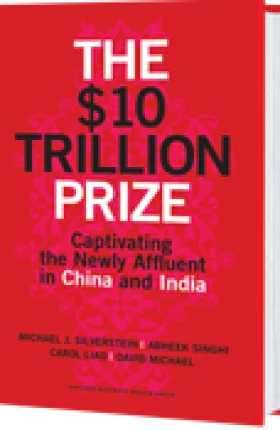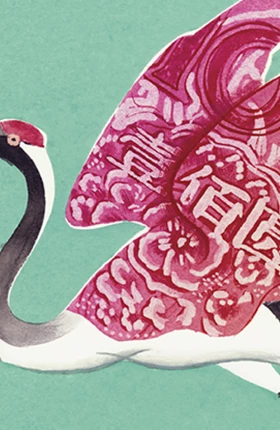Following recent declines in GDP growth in China and India, many are asking important questions: Have the two countries lost their way? Is China a bubble about to burst? Are India’s bureaucracy, corruption, and infrastructure issues insurmountable? Will income disparity create civil unrest comparable to an Arab Spring? Are political dysfunction and crony capitalism preventing reform? Will the next generation of leadership in the two countries change the dynamics in ways that are sufficient to provide enough jobs for their entry-level workers?
We believe that the answer to these questions is simple: China and India are in the midst of a revolution in growth. Risk and volatility are part of the bargain. We remain convinced that by the end of this decade, there will be 1 billion middle-class consumers in China and India—and both countries will have delivered long-term annual growth averaging 8 percent.
As we explain in our new book, The $10 Trillion Prize: Captivating the Newly Affluent in China and India, this growth will not occur along a straight line, and both countries will have to overcome corruption, imprudent investments, social disharmony, pollution, natural disasters, and political conflict. History is a good teacher. In the past, emerging-market countries have often experienced significant instability, with wide swings in yearly growth rates. The immaturity of their economies increases both risk and return.
Parallels with the Early U.S. Economy
The economic history of the United States following the Civil War is a good reference point. Between 1865 and 1915, the United States economy increased nearly sevenfold, and real incomes during this period increased at a compound annual rate of more than 2 percent. But there were considerably greater swings in annual economic growth than in more recent times. A similar progression is visible in China and India today.
In their classic text, A Monetary History of the United States, 1867–1960, Milton Friedman and Anna Jacobson Schwartz note that the time period between 1867 and 1879 had the highest-ever growth in the U.S. economy. It was a heady time in America. The major U.S. cities were beacons for the children of struggling farmers and day laborers from Ireland and Eastern Europe.
During the period between the Civil War and World War I, American consumers purchased their first packaged goods and factory-made clothing, and they moved into vertical dwellings—walk-up apartments whose construction required iron, glass, lumber, and cement. Consumers demanded electricity, new forms of mass transportation, and education for their children. Brands were invented. A middle class with ready cash soon emerged. These middle-class consumers demanded—and got—less corruption, less pollution, and less-dangerous industrial jobs. They had tremendous new energy and aspirations; they embodied a true American Dream. These Americans viewed themselves as having a unique place in world history and being the saviors of democracy and freedom.
During that time period, the number of railroads in the United States more than doubled and freight tonnage skyrocketed. Significant investment established the industrialization of the United States, including a colossal expansion of the telegraph, steel, coal, timber, and farming industries. The population increased by 30 percent as European immigrants arrived seeking higher real wages. The telephone, typewriter, and electric light were invented and commercialized. It was the time of the tycoon—John D. Rockefeller in oil, Andrew Carnegie in steel, J.P. Morgan in banking, and Jay Gould in railroads.
The parallel between the United States in the late nineteenth century and China and India today is uncanny in terms of not only growth and sweeping ambition but also the potential for short-term turmoil. Starting in September 1873, the United States was swept up in a financial crisis—the Panic of 1873. When global silver prices plummeted, the U.S. economy was hit directly. Because the United States was the largest producer of silver in the world at the time, U.S. businesses experienced a painful period of sustained instability. The New York Stock Exchange was closed for ten days, 89 of the nation’s 364 railroads went bankrupt, and unemployment reached 14 percent. In the winter following the Panic, more than a million workers were laid off. Labor unrest reached a peak. And there was a chain reaction of bankruptcies, depressed prices, and charges of fraud and over-building.
Yet out of the chaos of the Panic came opportunities—and the short-term correction did not prevent the economy from growing at a 4 percent compound annual rate between 1865 and 1915. Following the Panic, companies established themselves that today are world leaders. They invented methods for mass communication, brand development, industry consolidation, and the creation of immense wealth.
Similar economic turbulence is likely in India and China. Yet vast fortunes will be made there, too, over the next decade.
The Case for Growth
The thesis of The $10 Trillion Prize is that the economies of China and India will continue to grow and that annual consumer spending in the two countries combined will reach $10 trillion by 2020. Consumers with middle-class aspirations already number in the hundreds of millions in China and India—and by 2020, there will be nearly 1 billion middle-class Chinese and Indians. Over the current decade, 135 million Chinese and Indian citizens will obtain a college education. Meanwhile, labor productivity will increase dramatically as both countries continue the movement from rural agricultural economies to modern industrial powerhouses with investment in plants, infrastructure, modern housing, and dependable power at home and at work.
We believe that the case for momentous growth is persuasive on the basis of four fundamental growth drivers:
- A Booming Middle Class. China and India will see the rise of 300 million middle-class households with vitality, confidence, and eagerness to spend. There will also be a remarkable surge in so-called PhDs—the poor, hungry, and driven—with those between the ages of 20 and 30 outnumbering American youth by ten to one. These young people have boundless optimism and potential.
- Multiple Market Segments. The new consumers of China and India include high-income individuals and a vast middle class—but also an enormous number of people living below the poverty line who may soon leap forward into the middle class, a group we refer to as the next-but-one billion. Over the current decade, most spending will occur in the cities, but rural communities, if properly supported by government investment, will boom as well, with per capita income increasing across all of these segments.
- Changing Patterns of Trade, Technology, and Information. Revolutionary changes will make countries, consumers, and companies more closely interrelated than ever before. Market penetration will require rapid-fire response times and the ability to master local differences and customize to each segment, imitating and then improving upon incumbent products and brands. Hypercompetition will follow and new alliances will be required, sometimes bringing rivals together in new co-ventures.
- The Distinct Role of Government. In both India and China, the role of government is different than in the West. The two governments invest in and interact with business organizations in much more complex ways, and their influence in these partnerships is profound. In both countries, the government can act as an inhibitor or a patriarch, a corrupt entity that has to be circumvented or a proud national sponsor of industry—safeguarding citizens and ready to invest billions.
But this consumer-driven growth is only the first burst of historic economic energy. It will also lead to enormous global infrastructure projects, mostly involving roads, telecom, power, airports, water, health care, and educational institutions. It will drive the rise of powerful, capital-rich companies in China and India, many with official and unofficial state backing and 50-year time frames. It will create worlds of disparity with distinct groups of haves and have-nots, where the rich work and live side-by-side with the poor. There will be massive income growth in China, in contrast with very modest growth in the United States and the West.
India, too, is at an inflection point. The cronyism and corruption that tarnish its democracy, and the gaping disparity among its social classes, need to give way to fundamental change, to fully ethical and accountable government leadership, collaboration, and investment across all sectors.
Prodigious new consumption in China and India will also lead to increased environmental hazards, urban sprawl, and massive boom-or-bust industrial projects. In both countries, there will be ongoing battles between harmony and stability, greed and fear.
There is a second-order consequence of all this growth. We call it the boomerang effect because of all the ways in which rising demand in China and India for everything from food and water to housing, luxury goods, transport, and education will boomerang back to Western nations—leading to price volatility, inflation in supply-constrained commodities, scarcity of resources, and hypercompetition. The boomerang effect will mean chasing new consumers around the world, learning new lessons, meeting competition in all its forms, and playing on a field where the winner takes the globe.
Some companies and people will lose—the slow-to-move and the uneducated will fall victim. There will be tragedies of corporate indecision: failed investments, conflicting priorities, the wrong products, the wrong distribution chains, leadership sacrificed, and fortunes lost. Winning a slice of the prize will take considerable courage and perseverance—on the part of CEOs and politicians alike.
Winning in the New Global Marketplace
In order to achieve an 8 percent average growth rate over the next few years, both China and India will need to overcome bureaucracy, bribery, and corruption. The World Bank ranks India 132 out of 185 countries for “ease of doing business.” China is ranked 91—below Rwanda, Namibia, and Mongolia. Corruption takes many forms, from outright bribes to red tape and bureaucratic obstacles.
The two countries must also invest heavily in education. China and India will enjoy stronger fundamental growth and advantage if they dramatically increase investment in their schools and universities. China needs to develop more elite graduate programs, recruit world-class faculty, and use its wealth to create curricula to rival such great research universities in the West as Massachusetts Institute of Technology, Harvard University, and California Institute of Technology. India desperately needs to invest in both primary and higher education to break the cycle of poverty for the poorest third of its population—and create incentives for the best and brightest to stay in India. For that matter, the United States needs to raise graduation rates, spur the growth of entry-level jobs, and divert resources to math and science in order to remain competitive.
Winning will also require a tolerance for extreme volatility, which is a fact of life in emerging markets. Much of the demand by middle-class consumers for a better life takes the form of demand for capital goods. Housing, cars, appliances, dependable utilities, hospitals, and schools all require long planning horizons to allow for increased production. By the time producers have added capacity to meet demand, softness in exports or job markets can shrink that demand. The luxury housing market in the major cities in China is a good example—for a decade it seemed only to go up, but in many major cities today, the demand for houses valued at $1 million or more has shriveled. The market for capital goods is inherently boom or bust.
Nevertheless, as we ponder the next decade, we believe that the ambition, energy, and relentlessly optimistic mindset of the billion newly affluent Chinese and Indians will prevail. Our book, and the series of Perspectives based on the book, offers a manifesto for growth and wealth
We urge you to begin the journey of understanding these countries and their people in an “up close and personal” way. We urge you to begin to segment the various markets by income, region, and ethnicity. We urge you to bring deep and original thinking to your marketing. We urge you to build a paisa vasool approach—the perfect mix of features and benefits at an affordable price—into all your product development. We think that this approach will become the standard in Chinese, Indian, and Western markets. And we believe that it can end in a triple win overall—with China, India, and the West all prospering.
Over the next few years, China and India will deliver the largest-ever unfolding of consumer markets in history. But there will be volatility, risks, and obstacles—and determined, well-funded local competitors. We believe that there is no choice but to meet them in the marketplace. The extraordinary opportunity in China and India will be seized by the bold, the wise, and the courageous.





